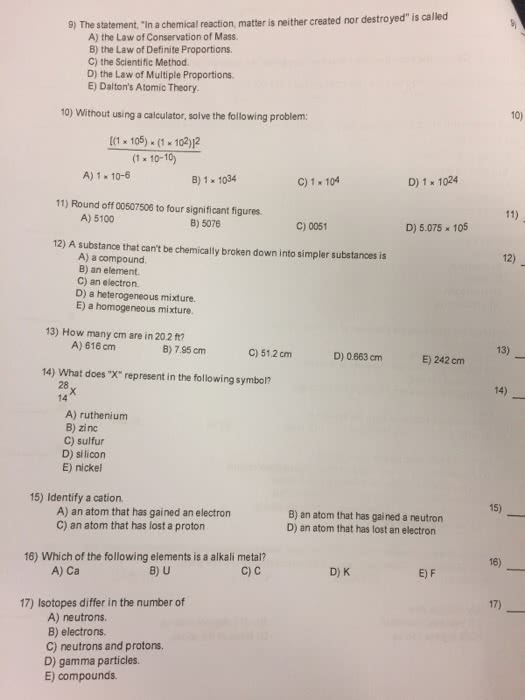ENVS 010 Lecture Notes - Lecture 1: Relative Atomic Mass, Chemical Bond, Atomic Number
Document Summary
Get access


Related Documents
Related Questions
Flag this Question
Question 211 pts
Blood cells placed in pure water will burst because there is a net movement of water out of the cell.
| True |
| False |
Flag this Question
Question 221 pts
Photosynthesis takes place in tiny organelles within the cell known as mitochondria.
| True |
| False |
Flag this Question
Question 231 pts
The balanced chemical equation for cellular respiration is
C6H12O6 + 6O2 â 6CO2 + 6 H2O + 36 or 38 ATP
| True |
| False |
Flag this Question
Question 241 pts
A catalyst is anything that speeds up a chemical reaction.
| True |
| False |
Flag this Question
Question 251 pts
Kinetic energy is the energy an object possesses due to its motion.
| True |
| False |
Flag this Question
Question 261 pts
Changes in temperature and pH may speed up or slow down the activity of an enzyme.
| True |
| False |
Flag this Question
Question 271 pts
There are 20 different amino acids.
| True |
| False |
Flag this Question
Question 281 pts
The products of the light-dependent reactions of photosynthesis are oxygen, ATP, and NADPH.
| True |
| False |
Flag this Question
Question 291 pts
Which of the following is NOT a component of the Cell Theory?
| Cells arise only by division of a previously existing cell. |
| Cells are the smallest units of structure and function |
| All organisms are composed of one or more cells. |
| Cells can vary their shape and size to suit the environment for survival. |
Flag this Question
Question 301 pts
What is the name of the two subatomic particles that can be found in the nucleus of an atom?
| neutrons and electrons |
| protons and neutrons |
| protons and electrons |
| protons and morons |
Flag this Question
Question 311 pts
Atoms that have either a positive or negative charge are known as:
| ions |
| magnetic |
| lacking nuclei |
| electrically neutral |
Flag this Question
Question 321 pts
An atom with an unfilled outer energy level (electron shell) is likely to be:
| inert |
| unable to form bonds with other atoms |
| reactive |
| extremely stable |
Flag this Question
Question 331 pts
All living things are able to maintain stable internal conditions. This is known as
| metabolism |
| homeostasis |
| heredity |
| cellular organization |
Flag this Question
Question 341 pts
Which of the following is NOT considered to be one of the five basic properties shared among living organisms?
| made of one or more cells |
| grow and reproduce |
| posses DNA |
| need oxygen to survive |
Flag this Question
Question 351 pts
CFCs (Chlorofluorocarbons) in the stratosphere cause:
| global warming due to increased CO2 |
| increase ozone levels by converting O2 to O3 and decreasing UV passage to Earth. |
| act as a catalyst to destroy ozone increasing UV passage to Earth. |
| increased ice crystal formation that cools the earth. |
Flag this Question
Question 361 pts
The process by which traits are passed from parents to offspring is known as:
| heredity |
| homeostasis |
| complexity |
| movement |
Flag this Question
Question 371 pts
Alcoholic fermentation occurs in muscle cells of the human body.
| True |
| False |
Flag this Question
Question 381 pts
If carbon has 6 protons and 6 neutrons, how many electrons must it have to be electrically neutral?
| 3 |
| 36 |
| 6 |
| 12 |
Flag this Question
Question 391 pts
The loss of an electron is known as _______; the gain of an electron is known as ________.
| reduction; oxidation |
| transduction; adduction |
| oxidation; reduction |
| removal; addition |
Flag this Question
Question 401 pts
Kinetic energy is the stored energy that can be used for motion.
| True |

